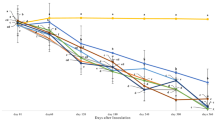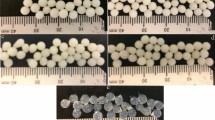Abstract
The present study was an attempt to evaluate the bio-formulations of phosphate-solubilizing fungus Aspergillus awamori S29 using two economically viable carriers (calcium alginate and agar) in repeated batch fermentation. Further, the viable cell count under storage and response of these stored bio-formulations on the growth of wheat plants were studied at the end of 2, 4, and 6 months of incubation. Also, the response of these formulations in next season on pearl millet (bajra) was studied without further inoculation. In repeated batch fermentation assay, immobilized form performed significantly better than free form. The viability of fungal inoculant was 88.2% in calcium alginate-based bio-formulation after six months of storage. These bio-formulations showed not only a statistically significant increase in the growth of wheat crop in first season but also of pearl millet in next season. This work strengthens the re-usability potential of immobilized bio-formulations for next season crop.





Similar content being viewed by others
References
Saharana S, Srivastava SK, MVRK, Sharma R, Johri AK, Prakash BN, Sahai A, Bisari V, (2010) Development of non-sterile inorganic carrier-based formulations of fluorescent pseudomonad R62 and R81 and evaluation of their efficacy on agricultural crops. Appl Soil Ecol 46:251–258
Vimal SR, Singh JS, Arora NK, Singh S (2017) Soil-plant-microbe interactions in stressed agriculture management: a review. Pedosphere 27(2):177–192
Meftah Kadmiri I, El Mernissi N, Azaroual SE et al (2021) Bioformulation of microbial fertilizer based on clay and alginate encapsulation. Curr Microbiol 78:86–94
Lumsden RD, Lewis JA, Fravel DR (1995) Formulation and delivery of biocontrol agents for use against soil borne plant pathogens. In: Hall FR, Barry JW (eds) Biorational Pest Control Agents. American Chemical Society, Washington DC
Omer M (2010) Bioformulations of Bacillus spores for using as biofertilizer. Life Sci 7:124–131
Sarma MVRK, Kumar V, Saharan K, Srivastava R, Sharma AK, Prakash A, Sahai V, Bisaria VS (2011) Application of inorganic carrier based formulations of fluorescent pseudomonads and Piriformospora indica on tomato plants and evaluation of their efficacy. J Appl Microbiol 111:456–466
Maheshwari DK, Dubey RC, Agarwal M, Dheeman S, Aeron A, Bajpai VK (2015) Carrier based formulations of biocoenotic consortia of disease suppressive Pseudomonas aeruginosa KRP1 and Bacillus licheniformis KRB1. Ecol Eng 81:272–277
Sun D, Hale L, Crowley D (2016) Nutrient supplementation of pinewood biochar for use as a bacterial inoculum carrier. Biol Fertil Soils 52:515–522
Tripti K, Adarsh U, Zeba K, Vipin A (2017) Biochar and flyash inoculated with plant growth promoting rhizobacteria act as potential biofertilizer for luxuriant growth and yield of tomato plant. J Environ Manag 190:20–27
Takei T, Yoshida M, Hatate Y, Shiomori K, Kiyoyama S (2008) Lactic acid bacteria enclosing poly (ε-caprolactone) microcapsules as soil bioamendment. J Biosci Bioeng 106:268–272
Covarrubias SA, Bashan LE, Moreno M, Bashan Y (2012) Alginate beads provide a beneficial physical barrier against native microorganisms in wastewater treated with immobilized bacteria and microalgae. Appl Microbiol Biotechnol 93:2669–2680
Lobo CB, Tomas MSJ, Virull E, Ferrero MA, Lucca ME (2019) Development of low-cost formulations of plant growth-promoting bacteria to be used as inoculants in beneficial agricultural technologies. Microbiol Res 219:12–25
Van Elsas JD, Trevors JT, Jain D, Woiters AC, Heijnen CE, Van Overbeek LS (1992) Survival of, and root colonization by, alginate-encapsulated Pseudomonas fluorescens cells following introduction into soil. Biol Fertil Soils 14:14–22
Jain R, Saxena J, Sharma V (2010) The evaluation of free and encapsulated Aspergillus awamori for phosphate solubilization in fermentation and soil-plant system. Appl Soil Ecol 46:90–94
Hale L, Luth M, Kenney R, Crowley D (2015) Evaluation of pinewood biochar as a carrier of bacterial strain Enterobacter cloacae UW5 for soil inoculation. Appl Soil Ecol 84:192–199
Tamreihao K, Ningthoujam DS, Nimaichand S, Singh ES, Reena P, Singh SH, Nongthomba U (2016) Biocontrol and plant growth promoting activities of a Streptomyces corchorusii strain UCR3-16 and preparation of powder formulation for application as biofertilizer agents for rice plant. Microbiol Res 192:260–270
Lucero CT, Lorda GS, Anzuay MS et al (2021) Peanut endophytic phosphate solubilizing bacteria increase growth and P content of soybean and maize plants. Curr Microbiol 8:1961–1972
Vassilev N, Vessileva M, Azcon R, Medina A (2001) Interaction of an arbuscularmycorrhizal fungus with free or co-encapsulated cells of Rhizobium trifoli and Yarowina lipolytica inoculated in a soil-plant system. Biotechnol Lett 23:149–151
Vassileva M, Azcon R, Barea JM, Vassilev N (1999) Effect of encapsulated cells of Enterobacter sp. on plant growth and phosphate uptake. Bioresour Technol 67:229–232
Vassilev N, Toro M, Vassileva M, Azcon R, Barea JM (1997) Rock phosphate solubilization by immobilized cells of Enterobacter sp. in fermentation and soil conditions. Bioresour Technol 61:29–32
Trivedi P, Pandey A (2008) Recovery of plant growth-promoting rhizobacteria from sodium alginate beads after 3 years following storage at 4 degrees. J Ind Microbiol Biotechnol 35:205–209
Jain R, Saxena J, Sharmam V (2014) Differential effects of immobilized and free forms of phosphate solubilizing fungal strains on the growth and phosphorus uptake of mung bean plants. Ann Microbiol 64(4):1523–1534
Wu Z, Zhao Y, Kaleemm I, Li C (2011) Preparation of calcium–alginate microcapsuled microbial fertilizer coating Klebsiella oxytoca Rs-5 and its performance under salinity stress. Eur J Soil Biol 47:152–159
Rekha PD, Lai WA, Arun AB, Young CC (2007) Effect of free and encapsulated Pseudomonas putida CC-FR2-4 and Bacillus subtilis CC-pg104 on plant growth under gnotobiotic conditions. Bioresour Technol 98:447–451
Minaxi SJ (2011) Efficacy of rhizobacterial strains encapsulated in nontoxic biodegradable gel matrices to promote growth and yield of wheat plants. Appl Soil Ecol 48:301–308
Jain R, Saxena J, Sharma V (2012) Effect of phosphate solubilizing fungi Aspergillus awamori S29 on mungbean (Vigna radiata cv. RMG 492) growth. Folia Microbiol 57:533
Murphy J, Riley HP (1962) A modified single solution method for the determination of phosphate in natural waters. Anal Chim Acta 27:31–36
Whitelaw MA, Harden TJ, Helyar KR (1999) Phosphate solubilization in solution culture by the soil fungus Penicillium radicum. Soil Biol Biochem 32:655–665
El-Komy HMA (2005) Co-immobilization of Azospirillum lipoferum and Bacillus megaterium for plant nutrition. Food Tech Biotechnol 43:19–27
Gul O, Dervisoglu M (2016) Application of multicriteria decision technique to determine optimum sodium alginate concentration for microencapsulation of Lactobacillus casei Shirota by extrusion and emulsification. J Food Process Eng 40(3):1–10
Lotfipour F, Mirzaeei S, Maghsoodim M (2012) Preparation and characterization of alginate and psyllium beads containing Lactobacillus acidophilus. Sci World J. https://doi.org/10.1100/2012/680108
Bassani JC, Queiroz Santos VA, Barbosa-Dekker AM, Dekker RFH, da Cunhaa MAA, Pereira EA (2019) Microbial cell encapsulation as a strategy for the maintenance of stock. LWT - Food Sci Technol 102:411–441
Duan W, Yang E, Xiang M, Liu X (2008) Effect of storage conditions on the survival of two potential biocontrol agents of nematodes, the fungi Paecilomyces lilacinus and Pochonia chlamydosporia. Biocontrol Sci Technol 18:605–612
Kaushik P, Mishra A, Malik A, Sharma S (2015) Production and shelf-life evaluation of storable myco-granules for multiple environmental applications. Int Biodeterior Biodegrad 100:70–78
Krasaekoopt W, Bhandari B, Deeth H (2003) Evaluation of encapsulation techniques of probiotics for yoghurt. Int Dairy J 13(1):3–13
John RP, Tyagi RD, Brar SK, Surampalli RY, Prevost D (2011) Bioencapsulation of microbial cells for targeted agricultural delivery. Crit Rev Biotechnol 31:211–226
Rabin N, Zheng Y, Opoku-Temeng C, Du Y, Bonsu E, Sintim HO (2015) Biofilm formation mechanisms and targets for developing antibiofilm agents. Future Med Chem 7:493–512
Kaminsky LM, Trexler RV, Malik RJ, Hockett KL, Bell TH (2019) The inherent conflicts in developing soil microbial inoculants. Trends Biotechnol 37(2):140–151. https://doi.org/10.1016/j.tibtech.2018.11.011
Vassilev N, Vassileva M, Martos V, Garcia del Moral LF, Kowalska J, Tylkowski B, Malusá E (2020) Formulation of microbial inoculants by encapsulation in natural polysaccharides: focus on beneficial properties of carrier additives and derivatives. Front Plant Sci 11:270
Klaic R, Guimarães GGF, Giroto AS et al (2021) (2021) Synergy of Aspergillus niger and components in biofertilizer composites increases the availability of nutrients to plants. Curr Microbiol 78:1529–1542
Vassilev N, Medina A, Azcon R, Vassileva M (2006) Microbial solubilization of rock phosphate on media containing agro-industrial wastes and effect of the resulting product on plant growth and P-uptake. Plant Soil 287:77–84
Guimarães GGF, Klaic R, Giroto AS, Majaron VF, Avansi W, Farinas CS et al (2018) Smart fertilization based on sulfur-phosphate composites: synergy among materials in a structure with multiple fertilization roles. ACS Sustain Chem Eng 6(9):12187–12196
Bernabeu PR, García SS, López AC, Vio SA, Carrasco N, Boiardi JL, Luna MF (2018) Assessment of bacterial inoculant formulated with Paraburkholderia tropica to enhance wheat productivity. World J Microbiol Biotechnol 34:81
Elzein A, Brändle F, Cadisch G, Kroschel J, Marley P, Thines M (2008) Fusarium oxysporum strains as potential striga mycoherbicides: molecular characterization and evidence for a new forma specialis. The Open Mycology J 2:89–93
Connick WJ, Boyette CD, Mc Alpine JR (1991) Formulation of mycoherbicides using a pasta-like process. Biol Control 1:281–287
Joe MM, Saravanan VS, Islam MR, Sa T (2014) Development of alginate-based aggregate inoculants of Methylobacterium sp. and Azospirillum brasilense tested under in vitro conditions to promote plant growth. J Appl Microbiol 116:408–423
Acknowledgements
Authors are grateful to the Vice-Chancellor of the Banasthali University for providing the facilities to carry out the work.
Funding
This work was funded by the University Grant Commission (UGC), India and Department of Science and Technology (DST) India.
Author information
Authors and Affiliations
Contributions
RJ was PI of the project and performed lab work, writing, and statistical analysis; AG did all the experimental work; VS contributed to conceptualization; S.N. Naik contributed to reviewing and editing of the manuscript; JS contributed to writing and editing of the manuscript, RP contributed to review and editing of manuscript; VK contributed to revision and editing of manuscript.
Corresponding authors
Ethics declarations
Conflict of interest
The authors declare no conflict of interest.
Research Involving Human and Animal Participants
This article does not contain any studies with humans or animal.
Additional information
Publisher's Note
Springer Nature remains neutral with regard to jurisdictional claims in published maps and institutional affiliations.
Supplementary Information
Below is the link to the electronic supplementary material.
Rights and permissions
About this article
Cite this article
Jain, R., Gupta, A., Sharma, V. et al. Immobilization-Based Bio-formulation of Aspergillus awamori S29 and Evaluation of Its Shelf Life and Re-usability in the Soil–Plant Experiment. Curr Microbiol 79, 163 (2022). https://doi.org/10.1007/s00284-022-02854-0
Received:
Accepted:
Published:
DOI: https://doi.org/10.1007/s00284-022-02854-0




